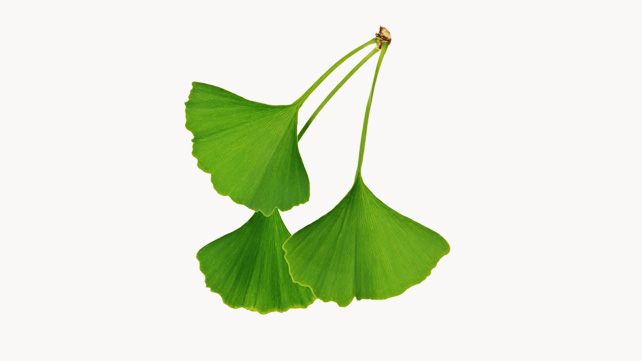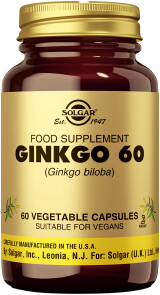
- Formula for the ability to concentrate
- Nootropic with ashwagandha, ginkgo, bacopa, caffeine, pterostilbene and lutein

- Contains 120 mg of ginkgo biloba per capsule
- Highly dosed

- Contains Virtiva®, a combination of Ginkgo biloba extract and phosphatidylserine
- Highly dosed

- Contains the standardized extract in combination with the whole herb
- Standardization guarantees a constant amount of active ingredients

- Very pure: contains less than 5 ppm of ginkolic acids
- 40 mg per capsule

- Standardized extract; contains 21 mg of ginkgo flavone glycosides per capsule
- Contains the standardized extract in combination with the whole herb

- Nootropic with bacopa, lions mane, green tea and ginkgo biloba
- Formula for concentration, learning ability and memory

- Formula for mood
- Contains standardized extracts of St. Johns wort, ginkgo biloba and Siberian ginseng

- Formula for concentration, learning ability and memory
- Tincture with ginkgo, rhodiola, lion's mane and holy basil

- Tincture based on the ginkgo leaf, processed on the day of harvest
- 1 ml corresponds to 500 mg of leaf

- Contains 120 mg of ginkgo biloba per capsule
- Highly dosed

- Standardized extract
- Contains 15.6 mg ginkgo flavone glycosides per capsule

- Contains 400 mcg folic acid and 1000 mcg vitamin B12 per chewable tablet
- alcohol-based herbal tincture

- Formula with antioxidant properties especially for digestion
- Contains common club moss, dandelion, olive tree, ginkgo biloba and bladderwrack

- Contains 120 mg of ginkgo biloba per capsule
- Highly dosed
Buy the best Ginkgo Biloba supplements here. Or read more about Ginkgo Biloba below.

Ginkgo Biloba is good for the brain. It improves concentration, memory and mental performance in general. In addition, Ginkgo supports blood circulation*.

How Ginkgo works
The leaves, fruits, and seeds of the Ginkgo tree have been used since the 11th century in traditional Chinese medicine. We now know that the active compounds include flavonoids (flavon glycosides) and terpenoids (terpene lactones).
These ensure that Ginkgo extract functions as an antioxidant. Additionally, it supports the brain, memory, concentration, and the nervous system*. Ginkgo is also known for contributing to healthy circulation, particularly blood flow in the capillaries*.
Ginkgo Biloba is one of the most studied herbs in the world. More than 400 scientific studies have been conducted on the effects of Ginkgo Biloba.
* Health claim(s) pending approval by the European Commission.
Wat is Ginkgo biloba
The Ginkgo biloba tree is probably the oldest living tree species in the world. Despite being known in the Netherlands as Japanese nut tree or temple tree, the ginkgo is originally from China. It was not brought to Japan until the 14th century.
The tree plays a major role in Japanese culture. For example, it was grown as a religious symbol at temples, and artists throughout the ages used the ginkgo as a source of inspiration. The ginkgo leaf is even the emblem of the city of Tokyo.
The most distinctive feature of the Ginkgo biloba tree is the unique shape of its leaves. They are like fans, with the veins radiating out into the leaf. At the base, two main veins define the shape, which is what the term biloba refers to (literally, it means two-lobed).
Another characteristic of the Ginkgo tree is the color of its leaves in autumn. These turn saffron yellow in color, which is a beautiful sight, especially when the sun shines on them. Usually they fall from the tree in a very short period of time which creates a beautiful yellow carpet under the tree.
By the way, Ginkgo biloba is often misspelled, for example as Gingko or Ginko biloba.
Experiences with Ginkgo biloba
The experiences of people who take a Ginkgo biloba supplement vary. The effect of Ginkgo biloba depends on the quality of the supplement used.
Ginkgo biloba is often used for its positive effects on learning ability.
Ginkgo is especially effective when standardized and easily absorbable extracts are used. A good example is the patented Ginkgo extract Virtiva® used in Vitals Ginkgo Biloba-PS capsules.
Ginkgo safe
Numerous studies have shown that the use of Ginkgo supplements is safe. Slight side effects such as intestinal discomfort, headache or dizziness may occur in some cases. These are transient in nature. However, it is advised to stop taking Ginkgo supplements a week before surgery, as it has a blood-thinning effect.
People taking blood-thinning medication and/or medication for high blood pressure are therefore advised to contact their practitioner when considering taking a Ginkgo supplement. It is also not recommended for use during pregnancy and lactation.
When the above is observed and a supplement of a reputable brand is chosen, the use of Gingko biloba poses no dangers.
Buy a ginkgo biloba supplement
Meanwhile, the use of Ginkgo supplements is becoming more widespread. In nutrition and phytotherapy, Ginkgo is classified among the herbs.
There are of brands on the market in the form of capsules, tablets or tinctures. To make the right choice, it is important that a minimum of active substances are lost in production and that no additives are used that can hinder absorption or cause allergies.
In addition, it is important to know that standardized extracts provide certainty about the amount of bioactive substances a product contains).
Smeets & Graas offers a wide selection of quality Ginkgo biloba supplements. Both as a single product or as part of formula products.
Written by: Marcella van der Wel
Reviewed by: Liesbeth Thoen
Updated: January 24, 2025
